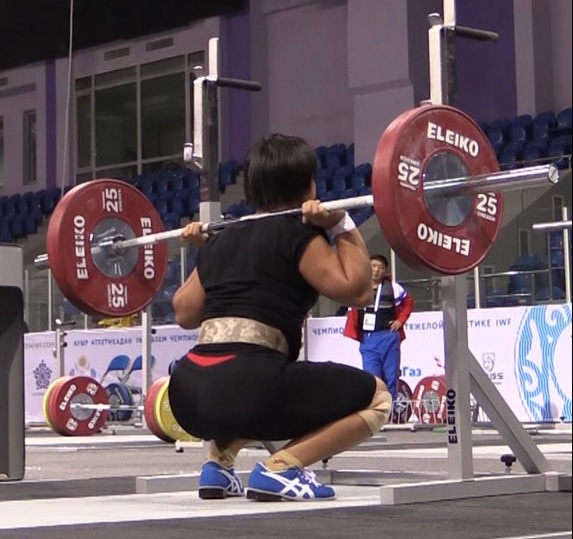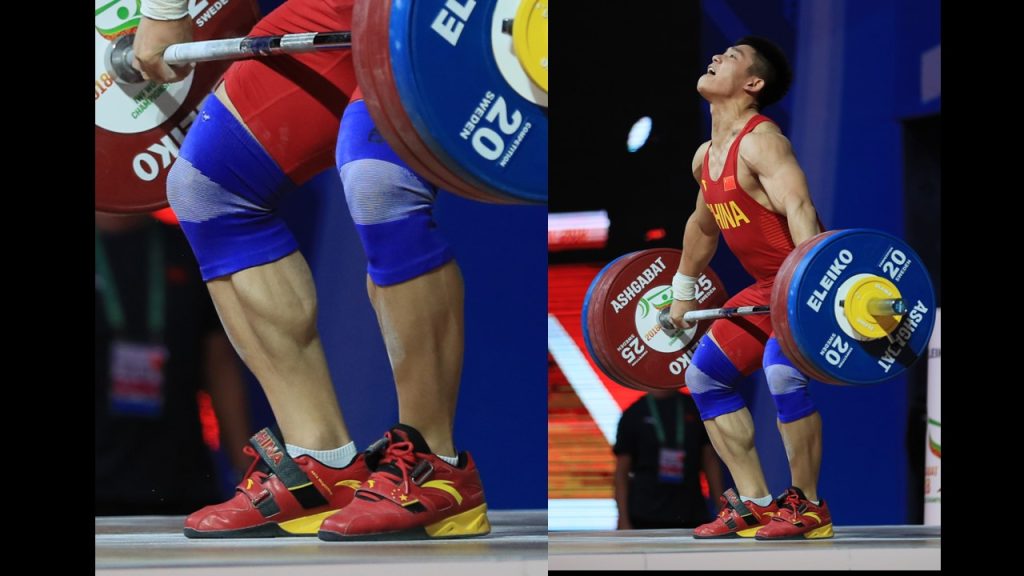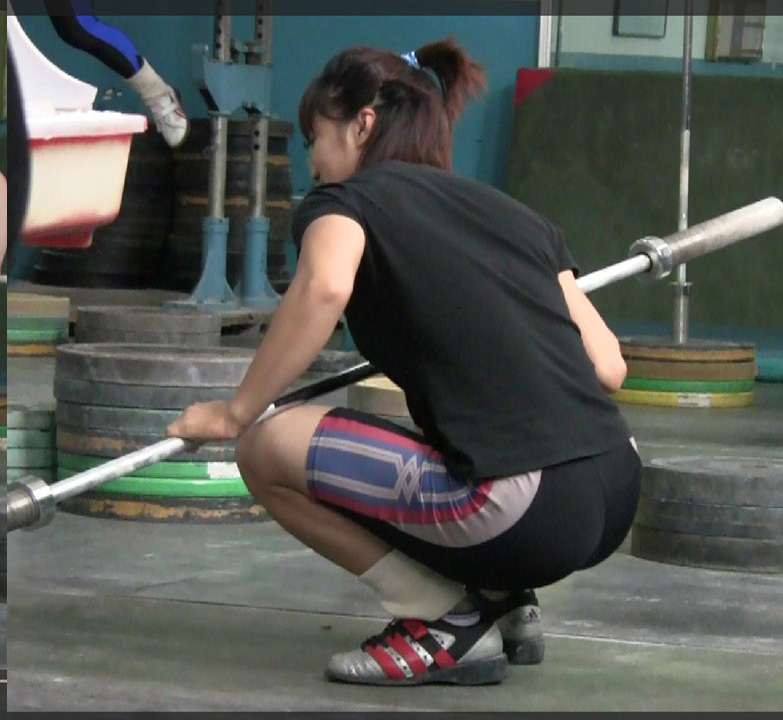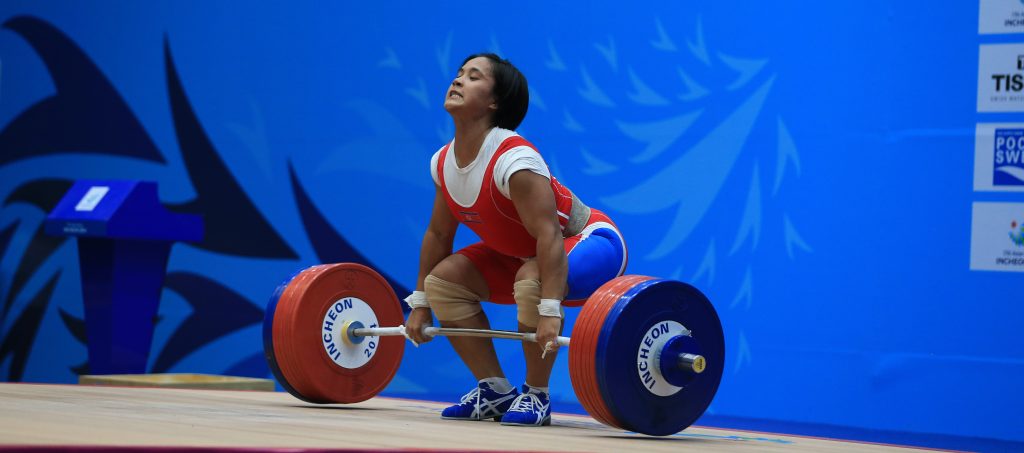‘Ankle Squats’
Andrew Charniga
www.sportivnypress.com
Weightlifting exercises useful for strength and suppleness not on paper
Coordinating the strength of the legs
Several essays have dealt with the critical role of tendons, ligaments and fascia of the weightlifter’s ankles and feet. Obvious deficiencies of the Soviet technique protocols were exposed relative to the subordinate role assigned the weightlifter’s muscles and springs located closest to the support (Charniga, A., www.sportivnypress.com; European weightlifting federation science journal). These deficiencies of logic were exposed relative to the effectiveness of an ‘Asian pull’ technique variation in performing the classic exercises.
Spring – like mechanisms; the tendons and ligaments and even the fascia (plantar) of the feet and ankle (shank) are interconnected in series to the rest of the muscles and tendons of the leg. Hence, these springs arranged in series, are considered a single spring, i.e., many authors refer to it as the ‘leg spring’. The weightlifting records of today would be highly unlikely without supra energy enhancement from the elastic properties of the leg spring; especially the springs of the shank and feet.
The musculature of the shank; especially those muscles attached to the Achilles tendon play a critical role in the production of power by means of releasing elastic energy in many athletic events; weightlifting in particular. For instance, when a weightlifter shifts the knees under the barbell in the explosion phase of the pull the ankles (should) bend more than the knees. This re- bending of the knees, re – introduces not only the calf musculature; but, also stretches the Achilles tendon, and likewise causes, reflexively, what some would call a pre – mature rise onto the toes.
The re – bending with a rise onto the toes, amplifies the power of the thigh muscles. The power amplification emanates from the simultaneous contraction of muscle coupled with elastic recoil of tendons; even the fascia of the feet; all interconnected in series with ligaments and tendons of the lower extremities. This amplification of the power of muscle contraction arising from elastic recoil is made possible as the legs and trunk function as a single integrated, interconnected, interdependent, linkage of levers powered by muscles and the visco – elastic properties of Biosprings; collectively referred to a ‘leg spring’.
Figure 1. Squatting with feet inside the pelvis, i.e., ‘ankle squats’; with shins tilting forward as much as possible stretches the Achilles, the largest, strongest spring of the human body . Charniga photo.
Squatting with feet inside the pelvis, i.e., ‘ankle squats’; with shins tilting forward as much as possible (see figure and video); strengthens the calf musculature, especially soleus; by a process called reverse – origin – insertion – contraction. The soleus muscle is lengthened under tension; as the shins tilt forward. Subsequently, these muscles pull the shins backwards as they contract. Returning the shins from the tilted disposition acts to straighten knee and hip; as all links are interconnected through ankle, knee and hip joints.
“A muscle may act to accelerate the joints it does not span as much or more than joints it does span.” F.J. Zajac, 1993
In this manner, soleus and other plantar flexors make a major contribution to recovery from the low squat to fully extended knees and trunk. In addition, recovery without pausing in the low squat is tantamount to the recoil of energy from bouncing off springs (see figure 2).
Calf muscles are squatting muscles too
“the soleus acts to accelerate all three (ankle, knee, hip) joints into extension.” FE. Zajac, 1993
Soleus, an ankle muscle along with other single joint plantar flexors (attachments do not cross the knee joint) are synergistic knee and hip extensors (Zajac, 1993). The Soleus and other single joint plantar flexors are very active in pulling the shins back to a vertical disposition; which by means of inertial coupling straightens knee and hip joints in the process (Zajac, 1993); hence the name ‘ankle squats’. Calf muscles are squatting muscles too (See figure 1).
Figure 2. Example of a significant tilting of shins forward in low squat of the clean. A ‘reverse origin insertion contraction’ of soleus and other single joint plantar flexors combined with synergistic elastic recoil from the Achilles tendon contributes significant energy to the quadriceps and hip muscles in the recovery from the deep squat. Charniga photo.
Practice of an ‘ankle squat’ (feet inside the pelvis) variant should not have any negative carry – over to the classic exercises. On the contrary, the strength and suppleness developed would have a positive carry over because the leg muscles are strengthened for the squatting and recovery phases of the lifts. Furthermore, the suppleness and strength developed through the ankles would tend to have positive effect on the lifter’s technique and ability to generate power though the legs to the support.
For instance, ankle suppleness, is needed to generate power in the half squat phase of the jerk as well as the shifting the knees under the barbell in the pull phase of the snatch and the clean. This specificity of suppleness and strength are typically neglected (see figures 3 and 4).
Figures 3 & 4. Suppleness in the ankle joints (muscles, tendons, ligaments) facilitates a weightlifter’s ability to produce energy from the combination of reverse – origin – insertion – contraction of calf muscles as well as the elastic recoil of the Achilles tendons and others. Charniga photo.
“Realize that everything connects to everything else.” ― Leonardo da Vinci
At any rate, squatting with accentuation of the calf musculature is a logical method of strengthening of the legs; especially as many view the squat as an exercise solely for the thigh and hip muscles.
Figure 5. The large amplitude of bending in lower extremities to fix a weight in the clean and jerk would be expected to tear ligaments and destroy joints if laboratory speculation of the perceived danger of full flexion squatting were true. Charniga photo.
Muscle synchronization: large amplitude of bending lower extremities vs. a ‘mythogeny’ of squatting
An arbitrary stipulation of a lowest depth of squatting, the posture of the trunk; the disposition of the knee relative to the foot – in effect the degree of forward tilt of the shin are irrational, superfluous sources of controversy in the literature. No reasonable attempt at critical thinking is to be found.
A common sense approach is likewise lacking. The reason being this is primarily an academic debate; lacking in heuristics. That there is even a debate in the first place, centers around the fact the knowledge base begins and ends in the classroom.
The obvious point of reference in such a debate should focus on analysis of weightlifters who perform the classic weightlifting exercises (squat snatch and squat clean); then, work backwards, i.e., a reverse engineering approach.
A common sense heuristics; to understand the effectiveness of full range of motion from the experiences weightlifters; is either ignored and/or the biomechanics, the kinematics, the kinesiology involved in weightlifting are utterly misunderstood.
The following are glaring examples of the complete lack of critical thinking in the ongoing academic debate of how to perform knee bends (taken from Schoenfeld, B., et al 2012):
1/ a reliance on defining stress/strain limitations of knee tendons and ligaments i.e., contraindications, based on speculations emanating from laboratory measurements;
Speculation on the basis of laboratory measurements; as to potential hazards associated with stress/strain energies on the knees in deep squatting is utterly worthless; without an understanding of the Bio springs: tendons, ligaments, muscle and fascia; their capacity to redistribute and otherwise dissipate the forces on joints. Bio springs stretch and recoil; energy is absorbed – energy is released; the energy of bending redistributed.
Furthermore, energies the weightlifter’s joints are subject from dropping into a deep squat in the classic snatch and the clean and jerk; all the while the weightlifter’s body exceeds the acceleration of a free falling body; as well as encumbered with the weight of a heavy barbell; would be expected to blow out joints. How is that even possible to rapidly drop into a deep squat without being injured; were it not for the visco – elastic properties the weightlifter’s Bio-springs (tendons, ligaments, fascia, muscle) to dissipate and redistribute mechanical energy? Consequently, without this circumstance into consideration laboratory speculation is worthless.
2/ specificity in sport defined such that there is no need to bend further than the joint angles most typical of the activity, i.e., there is no need to bend further than say a half squat in most field or court sports.
Such anti – reasoning dates to the father of the American knee injury epidemic (Karl Klein, 1982, personal communication) who believed a maximum bend of up to a knee angle of 135º is reached; would suffice for training for sports; is an ignorance still fixed in a collective conscious:
“…few {sports} require flexion in which the top of the thigh is below parallel (deep squatting).” Schoenfeld, B., 2012)
At issue, the possibility of developing ‘internal resistance’ by artificially restricting movement is not considered. That is, until an athlete has to react to a slip or fall, being tackled or tackling an opponent;, and fails to dissipate the mechanical energy of the fall/tackle by rapidly flexing lower extremities well beyond 135º.
3/ safety defined by speculative laboratory measurements:
“… that adding load can increase the injury risk of deep squats. In healthy individuals, the patellofemoral stress associated with deep squatting is the primary risk of injury.”
See the contradictions to this idea put forth in #1.
4/ the value of involving and developing all the muscles as opposed to delimiting the muscles of the lower extremities;
“..This suggests that squatting below parallel will not increase muscle activation. Finally, consider what is functional for the individual and the sport, if deep squatting is not part of normal functioning, it may not be contributing to sport performance via specificity.”
First, it is necessary for athletes to cultivate a flexibility/mobility reserve. A mobility reserve is considered injury prophylactic (Moroz, 1982) .
How would sportsmen expect to fall, slip, tackle, and so forth, safely, if an athlete actively trains to restrict bending of lower extremities; and, in the process loses the ability to bend at knee, hip and especially ankle, without significant internal resistance (see figure 6)?
The ability to fall or slip without being injured is not part of the “normal functioning” argument; that is until an athlete has to rely on reflexes in order to flex lower extremities through a large amplitude of motion to fall safely. Which in and of itself, is common occurrence in most field sports: football, soccer, rugby, lacrosse.
Figure 6. An unanticipated slip or fall in the act of lifting a heavy barbell is mostly a non – event for weightlifters; especially females. Ligaments and tendons are Bio-springs which stretch and recoil just as springs do. The process of cultivating the springiness of tendons, ligaments and muscles and large range of motion in joints is injury prophylactic; whereas the practice of consciously restricting movements in joints is the dialectic opposite: an injury facilitator. Charniga photo.
A glaring flaw of logic emanating from laboratory speculation of the value of squatting is the involvement of muscles of the lower extremities.
Single joint muscles such as soleus and other single joint plantar flexors are ignored; yet they are very active in absorbing the energy of bending; especially as the thighs pass parallel. Furthermore, these muscles are very active synergists in straightening the knee joints through a process called inertia coupling (Zajac, 1993); and, in the process; dissipate much of the stress on the knee joint as an athlete descends into the lowest position.
5/ inertia coupling of muscles activated by squatting and springs – interconnected.
“quadriceps activity gradually increases as knee flexion increases up to 90°, and little evidence suggests increase activity past parallel.”
The above statement is nonsensical. It implies the sole aim of squats is to load quadriceps muscles. However, descending into the lowest squat with shins tilted; such that knees are well in front of toes; creates an optimum synergy of ankle, thigh and hip muscles. This synergy of contracting muscles is coupled to the additional energy released by the recoil of the Achilles tendon. The Achilles is stretched with the tilting of the shins; which in turn will release energy as the shins move towards the vertical.
Coincidentally, research confirms the safety of not restricting tilting of shins forward in squatting (see Hartman, 2013).
“….instructions about a restriction of the forward knee displacement have to be strictly avoided. This recommendation is based on a misinterpretation of existing data and should be removed in future practical literature.” Hartman, 2013
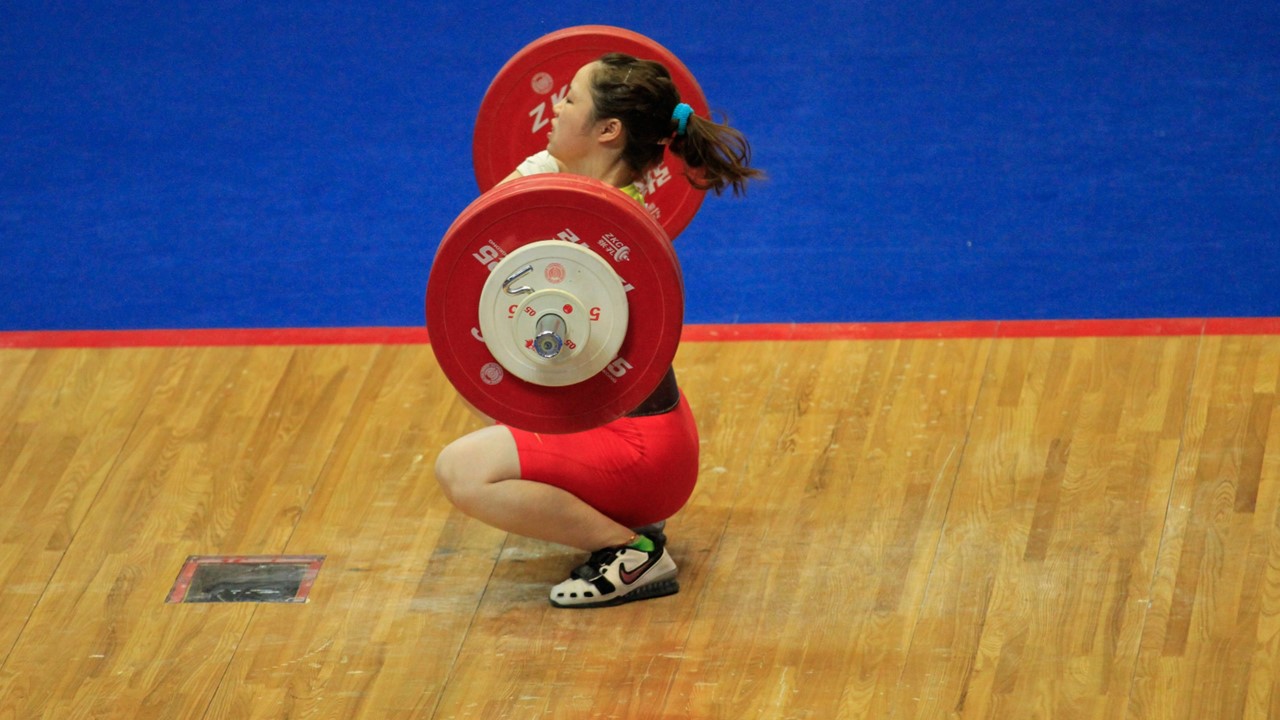
Figure 9. Female weightlifter cleaning heavy weight with hip joints directly over ankle joints and knee joints significantly in front of toes; with maximum stretching of Achilles tendon. Charniga photo.
This laboratory confirmation of Hartman (2013) has long since been unnecessary; as considerable empirical evidence has already proven this fact (see figure 9).
6/ squats for sale;
One can find in the literature, online videos and such, a dizzying myriad of squatting techniques; ridiculous for such a simple, basic exercise. There are two principle interconnected sources for the expansive range of technique opinions. One, is the belief deep knee bends will harm ligaments, false notions put forth by academia; two, ease of and motivation to commercialize information; which includes exercise techniques.
Squatting into a deep position with trunk as vertical as possible with shins tilting as far forward as comfortable is the safest most effective technique. Research of the effectiveness of this technique is unnecessary as sufficient empirical evidence exists to dispel doubters.
One important circumstance not considered is the near vertical disposition of the spine which occurs in the vertical trunk, shins tilted technique. The stress on the spine is far less than other techniques where the shins are kept near vertical. This forces the trunk forward for counterbalance; which in turn is an unjustified strain on the spine.
7/ the connection between the non – contact lower extremity injury epidemic to the practice of “constrained volatility” in the performance of simple exercise techniques has been documented (Charniga, www.sportivnypress.com).
Constrained volatility in the form of restricting movement of the shin and depth of squatting; as well as made up exercises designed to avoid a large amplitude of movement of the lower extremities; most certainly play a pivotal in injury susceptibility (see figures 7 & 8).
Ankle mobility (figure 7) is a critical element of weightlifting technique where ankle injuries are extremely rare, knee injuries rare and Achilles injury virtually unheard of. Conversely, poor mobility cultivated with ankle braces, taping ankle joints, high top shoes and so forth are injury facilitators (see figure 8).
Figure 7. Female weightlifter warming up for training with significant bending of lower extremities. Note – large tilting of shins in low squat with barbell resting on knees to force larger range of motion. Achilles ruptures are virtually unknown in weightlifting sport where large amplitude of motion exercises are not connected with injury. Charniga photo.
Figure 8. Professional women’s basketball (WNBA) at approximate instant of rupturing Achilles tendon {pushing off right foot, July 2023}. A a sad outcome of classroom/laboratory speculation bending beyond the typical limits of sport activity is useless; and, in the case of deep squatting dangerous. A false and hazardous (to the health and well being of athletes) assumption that constrained volatility is safe; bending unsafe. Note: Achilles ruptures, a common occurrence in American sport; are virtually unheard of in weightlifting; yet the mechanical energies this tendon is subject are exponentially greater than those of field or sports on courts. Charniga photo on right.
‘Ankle Pulls’
Andrew Charniga
www.sportivnypress.com
Weightlifting exercises useful for strength and suppleness not on paper
Weightlifters include high pulls in training to perfect technique and strengthen the legs, back and shoulder girdle, i.e., the muscles most active in pulling. For the most part the ankle muscles (gastrocnemius, soleus and other plantar flexors) are assigned an unjustified minor role in weightlifting (see Charniga, “Traps, Bats and Calves, www.sportivnypress.com); consisting of a rise onto the toes at the full extension of trunk and legs.
However, that being said, these muscles especially the single joint plantar flexor soleus muscles have to contract in a reverse origin – insertion to straighten the shin from a titled forward to a vertical disposition. The shifting from a tilted forward disposition to a vertical is further enhanced by the stretch – recoil release of elastic energy from the Achilles tendon and even the plantar fascia of the feet.
Although textbooks rarely make reference this possibility; it is a critical component of the weightlifter’s potential to produce maximum force.
A well known; but little understood exercise variant; is to perform the pull while standing on raised platform of more or less 10 centimeters (4 inches) in height (see figure).
From the starting position shown (with either snatch or clean hand spacing) a lifter proceeds to lift the bar to approximately knee height; then returns it to the platform for additional repetitions. This exercise forces the single joint calf muscles such as soleus to sustain a significant portion of the loading in order to straighten the shins from a tilted to a vertical disposition. Hence, the designation ‘ankle pulls’. Even though the legs are fully flexed in the start position there is little stress at the knees.
This exercise was a particular favorite of Vasilly Alexseyev (USSR). It is especially helpful to strengthen the muscles to separate the barbell from the floor. Difficulty at lift off from the floor is a common problem for young athletes, especially beginners. The extra difficulty incurred of lifting the barbell from a lower barbell height has a positive effect when the lifter switches to lifting the barbell from the usual height from the platform.
Figure 9. The role of single joint ankle muscles (soleus) are little understood yet are crucial for producing maximum power in the classic exercises and most power sports. They are generally the first muscles to fire when a lifter applies force to separate the barbell from the platform (Dvorkin, 2006). Charniga photo.
References
1/ Vorobeyev, A.N., Weightlifting, Textbook for the Institute of Sport, FIS, Moscow, 1988, Translated by Andrew Charniga
2/ Vorobeyev, A.N., Weightlifting, FIS, Moscow, 1978, Translated by Andrew Charniga
3/ Kanyevsky, V.B., “The starting position in the snatch and the clean and jerk for weightlifters of differing body types”, Dissertatsiia na coiskanie Uchenoi stepeni Kandidata pedagogicheskikh Hauk, 1983
4/ Zhekov, I.P., Biomechanics of the weightlifting exercises, FIS, Moscow, 1976.
5/ Schoenfeld, Brad MSc; Williams, Mary MA, “Are Deep Squats a Safe and Viable Exercise?”, Strength and Conditioning Journal 34(2):p 34-36, April 2012. | DOI: 10.1519/SSC.0b013e31824695a3
/ Charniga, A., “The foot, the Ankle Joint and Asian Pull”, www.sportivnypress.com
/ Charniga, A., “Variations of the Jump Under the Barbell in the Snatch and the Clean”. www.sportivnypress.com
/ Charniga, A., “Traps, Bats & Calves: Considerations for the Hungarian Start”, www.sportivnypress.com
/ Charniga, A., “Of Flat Tires and Brittle and Basketball Players”, ww.sportivnypress.com
/ Charniga, A., “Ankle Breakers and Glasket – ball”, www.sportivnypress.com
/ Charniga, A., “Achilles tendon ruptures and the NFL”, www.sportivnypress.com
Charniga, A., “Practical-solutions-to-the-problem-of-achilles-rupture-and-the-proliferation-of-injuries-to-the-lower-extremities-of-football-players”, www.sportivnypress.com
/ Charniga, A., “Muscles of the shank, movement of the shin & susceptibility to lower extremity injury”. 2020 ww.sportivnypess.com
/ Charniga, A., “Variations of the Jump Under the Barbell in the Snatch and the Clean”. www.sportivnypress.com
/ Charniga, A., “Of Flat Tires and Brittle and Basketball Players”, ww.sportivnypress.com
/ Charniga, A., “Ankle Breakers and Glasket – ball”, www.sportivnypress.com
/ Charniga, A., “Achilles tendon ruptures and the NFL”, www.sportivnypress.com
/ Zajac, F.E., “Muscle Coordination of Movement: A Perspective”, J. Biomechanics 26:suppl1:109-124:1993/
/ Zajac, F.E., “Understanding muscle coordination of the human leg with dynamic simulations”, J. Biomechanics 35:1011-1018:2002/
/ Underwood, J., “The knee is not for bending”, Sports illustrated, March 12, 1962/ Bobbert, M.F., Huijing, P.A.,
/ Jan Van Ingen Schenau, G., “An Estimation of Power Output and Work Done by the Human Triceps Surae Muscle – Tendon Complex in Jumping,” Journal Of Biomechanics, 19:11:899 – 906, 1986
/ Bobbert, M.F., Jan Van Ingen Schenau,G., “Coordination in Vertical Jumping,” Journal Of Biomechanics, 21:3:249 – 262, 1988.
/ Bobbert, M.F., Huijing, P.A., Jan Van Ingen Schenau, G., “A Model of the Human Triceps Surae Muscle – Tendon Complex Applied to Jumping,” Journal Of Biomechanics, 19:11:887 – 898, 1986

